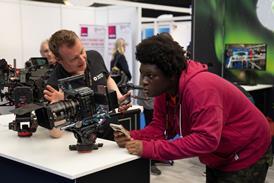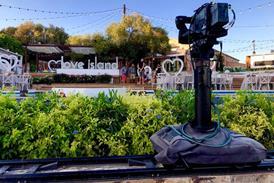IBC 2013: 4K technology will be the big story at this year’s IBC. Michael Burns takes a peak at some of the new products set to be unveiled at the Amsterdam trade show – and its packed schedule of conferences
Production
A 4K version of the XT3 production server is being introduced by EVS (Hall 8 Stand B90).
As well as enabling instant delivery of multicam footage to second screens and live slow motion in Ultra HD resolution, the company claims it offers greater flexibility and advanced workflows.
In terms of multiscreen delivery, EVS is introducing a workflow engine for high-speed news file ingest, editing and multi-platform delivery, which enables content gathering from sources including smart devices and social media.
It is also presenting improved multicam streaming capabilities (up to 12 HD streams per server) for the XS media server.
On the Grass Valley stand (Hall 1 Stand D11), non-linear video editing tool Edius 7 is making its debut.
A collaborative system for news and studio environments, it includes support for real-time 4K editing, as well as software integration with third-party input and output hardware from Blackmagic Design and Matrox.
Evertz (Hall 8 Stand B40) is introducing a suite of 4K/Ultra HD live work flow tools, including compression, routing, processing and conversion, monitoring and a unified control system.
It’s also showcasing new features for replay system Dreamcatcher, including 4K zoom and Mosaic, which enables real-time, simultaneous viewing of different camera angles.
Cinegy (Hall 7 Stand A30) will be introducing its 4K product line, comprising a multi view monitoring solution, called Cinegy Multiviewer, and Cinegy player, a broadcast video player for local or network use that supports 4K Sony XAVC.
Cameras
Only a few manufacturers have revealed the devices they will debut in Amsterdam. Panasonic (Hall 9 Stand C45) is showcasing its AK-HC3500A studio camera, which incorporates a 2/3-type 2.2 million pixel 3CCD for high sensitivity of F10 at 1080/59.94i and F11 at 1080/50i.
It also includes dynamic-range stretch functions as well as scene file settings.
Red’s (Hall 7 Stand H37) 6K Dragon sensor is set to make an appearance in the form of upgraded Red Epic and Scarlet models.
On the Sony stand (Hall 12) there will be a lot of interest in the PMW-300 camera, as well as the CBK-WA100, the new wireless adapter for XDCAM models.
This connects directly to a camera and allows XAVC proxy files to be created and saved on an SD card in the adapter, which then uploads the proxy content and the original high-resolution content via 3G/4G/LTE/Wi-Fi.
Cooke Optics (Hall 11 Stand D10) is presenting new additions to its miniS4/i lens range, which at 40mm and 65mm focal lengths are aimed at high-end drama and documentary use.
The company is also introducing a new lens test projector designed for today’s fast lenses.
Capture and storage
4K is also likely to dominate the Matrox stand (Hall 7 Stand B29), which will feature the company’s Mojito 4K, a quad 3G-SDI, 4K video monitoring card supporting frame rates of up to 60fps.
Sonnet (Hall 7 Stand G02), meanwhile, will be demonstrating Thunderbolt 2 technology in its Echo Express III Thunderbolt-to-PCI Express Card solutions, which come in desktop and rack-mount chassis versions.
Sony (Hall 12) is showing its expanded Optical Disc Archive systems, which include two drive units running at more than 1Gbps: the USB 3-powered ODS-D77U, and ODS-D77F, which features a highspeed fibre channel connection.
Cinedeck (Hall 10 Stand F39) is launching version 4.2 of its software, which is set to position its dual-channel RX and quad-channel MX file-based recorders against traditional tape decks in editorial and post-production, and increase the versatility of the recorders in digital cinema and broadcast workflows.
Post
Post-production is another area that has thrown its weight behind 4K.
Colorfront (on the AJA, Tangent and Sony stands) is previewing 4K and Ultra HD capabilities across its new product range, including On-Set Dailies 2014 and Transkoder 2014.
Quantel (Hall 7 Stand A20) is showing new software for its Pablo Rio colour-correction and finishing system.
Equipped with three Nvidia Tesla Kepler K20 GPUs, Pablo Rio can now deliver more than 20 layers of colour correction at 4K at full resolution in real-time, or around 50 layers at 2K.
Running on AJA Corvid Ultra, Pablo Rio can handle real-time 4K 60fps productions.
Still in 4K territory, SGO (Hall 6 Stand A11) is highlighting enhancements to its Mistika DI and Stereo 3D post system. Mistika Post Version 7.4 offers ACES-compliant colour-grading tools, with expanded real-time power to route and combine colour selections across any number of layers.
Bespoke filters can be created from any combination of effects and there’s a new Shape Tracker for one-click control of shape, stabilisation and motion-smoothing functions, as well as improved DCP creation tools including 60fps HFR support.
Adobe (Hall 7 Stand G27) is showcasing more than 25 new features for video products in its subscription-based Creative Cloud range, including Premiere Pro and Prelude.
Also on show is Adobe Anywhere for Video, a real-time cloud collaboration service for facilities.
Avid (Hall 7 Stand J20) will be revealing major enhancements to its Media Enterprise solutions, while Pro Tools 11 and Media Composer 7 will also make their debuts.
As well as the latest releases of its high-end software solutions, the Autodesk (Hall 7 Stand D25) stand will host guest presenters and announce the winner of the Flame Award, which highlights the work of VFX artists using the software.
Conferences
As usual, the IBC conference sessions highlight some of the newest ideas in advanced media technology, including two Cutting Edge sessions on Thursday 12 September about HDR video production issues (11am) and streaming immersive images (3pm).
The latter will feature a prototype system handling the transmission of 8K content through hybrid broadband/ broadcast networks.
It’s also a hot topic at 11am on Saturday, with The Great Quality Debate asking if broadcasters can afford to go beyond HD. Ultra HD remains on the agenda for Sunday, with SMPTE hosting a session at 8.30am looking at what HEVC brings to Ultra HD, followed by another on Ultra HD at 11.30am.
Multi-screen activity is another burning issue and an IBC conference theme in From Broadcast to Multicast: Collision, Casualties and Challenges.
A highlight will be Thursday’s keynote session at 1.45pm from Twitter UK general manager Tony Wang, who will discuss the company’s second screen advertising deals and TV ratings analysis, as well as its plans for the future of broadcasting.
The Second Screen and Social Innovations discussion panel at 11am on Friday will feature interactive programming pioneers and big players in multiplatform engagement.
Meanwhile, Show Me the Money: Where is the Value in Second Screen Content? at 3.30pm on Friday will discuss who is set to reap the financial rewards from the technology.
On Saturday, The Art & Science of Multi-Platform Commissioning at 11am will examine how new technologies can alter the way programmes are commissioned and developed.




























No comments yet